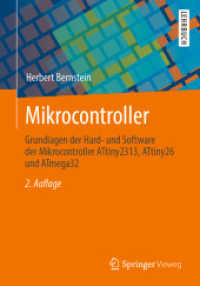- ホーム
- > 洋書
- > 英文書
- > Computer / General
Full Description
This much-anticipated revision, written by the ultimate group of top security experts in the world, features 40 percent new content on how to find security holes in any operating system or application
New material addresses the many new exploitation techniques that have been discovered since the first edition, including attacking "unbreakable" software packages such as McAfee's Entercept, Mac OS X, XP, Office 2003, and Vista
Also features the first-ever published information on exploiting Cisco's IOS, with content that has never before been explored
The companion Web site features downloadable code files
Contents
About the Authors vii
Acknowledgments xi
Introduction to the Second Edition xxiii
Part I Introduction to Exploitation: Linux on X 86
Chapter 1 Before You Begin 3
Basic Concepts 3
Memory Management 4
Assembly 6
Recognizing C and C++ Code Constructs in Assembly 7
Conclusion 10
Chapter 2 Stack Overflows 11
Buffers 12
The Stack 13
Functions and the Stack 15
Overflowing Buffers on the Stack 18
Controlling EIP 22
An Interesting Diversion 23
Using an Exploit to Get Root Privileges 25
The Address Problem 27
The NOP Method 33
Defeating a Non-Executable Stack 35
Return to libc 35
Conclusion 39
Chapter 3 Shellcode 41
Understanding System Calls 42
Writing Shellcode for the exit() Syscall 44
Injectable Shellcode 48
Spawning a Shell 50
Conclusion 59
Chapter 4 Introduction to Format String Bugs 61
Prerequisites 61
What Is a Format String? 61
What Is a Format String Bug? 63
Format String Exploits 68
Crashing Services 69
Information Leakage 70
Controlling Execution for Exploitation 75
Why Did This Happen? 84
Format String Technique Roundup 85
Conclusion 88
Chapter 5 Introduction to Heap Overflows 89
What Is a Heap? 90
How a Heap Works 91
Finding Heap Overflows 91
Basic Heap Overflows 93
Intermediate Heap Overflows 98
Advanced Heap Overflow Exploitation 105
Conclusion 107
Part II other Platforms—windows, Solaris, OS/X, and Cisco
Chapter 6 The Wild World of Windows 111
How Does Windows Differ from Linux? 111
Win32 API and PE-COFF 112
Heaps 114
Threading 115
The Genius and Idiocy of the Distributed Common Object Model and DCE-RPC 116
Recon 118
Exploitation 120
Tokens and Impersonation 120
Exception Handling under Win 32 122
Debugging Windows 124
Bugs in Win 32 124
Writing Windows Shellcode 125
A Hacker's Guide to the Win32 API 126
A Windows Family Tree from the Hacker's Perspective 126
Conclusion 127
Chapter 7 Windows Shellcode 129
Syntax and Filters 129
Setting Up 131
Parsing the PEB 132
Heapoverflow.c Analysis 132
Searching with Windows Exception Handling 148
Popping a Shell 153
Why You Should Never Pop a Shell on Windows 153
Conclusion 154
Chapter 8 Windows Overflows 155
Stack-Based Buffer Overflows 156
Frame-Based Exception Handlers 156
Abusing Frame-Based Exception Handling on Windows 2003 Server 161
A Final Note about Frame-Based Handler Overwrites 166
Stack Protection and Windows 2003 Server 166
Heap-Based Buffer Overflows 173
The Process Heap 173
Dynamic Heaps 173
Working with the Heap 173
How the Heap Works 174
Exploiting Heap-Based Overflows 178
Overwrite Pointer to RtlEnterCriticalSection in the PEB 178
Overwrite Pointer to Unhandled Exception Filter 185
Repairing the Heap 191
Other Aspects of Heap-Based Overflows 193
Wrapping Up the Heap 194
Other Overflows 194
.data Section Overflows 194
TEB/PEB Overflows 196
Exploiting Buffer Overflows and Non-Executable Stacks 197
Conclusion 203
Chapter 9 Overcoming Filters 205
Writing Exploits for Use with an Alphanumeric Filter 205
Writing Exploits for Use with a Unicode Filter 209
What Is Unicode? 210
Converting from ASCII to Unicode 210
Exploiting Unicode-Based Vulnerabilities 211
The Available Instruction Set in Unicode Exploits 212
The Venetian Method 213
An ASCII Venetian Implementation 214
Decoder and Decoding 218
The Decoder Code 219
Getting a Fix on the Buffer Address 220
Conclusion 221
Chapter 10 Introduction to Solaris Exploitation 223
Introduction to the SPARC Architecture 224
Registers and Register Windows 224
The Delay Slot 227
Synthetic Instructions 228
Solaris/SPARC Shellcode Basics 228
Self-Location Determination and SPARC Shellcode 228
Simple SPARC exec Shellcode 229
Useful System Calls on Solaris 230
NOP and Padding Instructions 231
Solaris/SPARC Stack Frame Introduction 231
Stack-Based Overflow Methodologies 232
Arbitrary Size Overflow 232
Register Windows and Stack Overflow Complications 233
Other Complicating Factors 233
Possible Solutions 234
Off-By-One Stack Overflow Vulnerabilities 234
Shellcode Locations 235
Stack Overflow Exploitation In Action 236
The Vulnerable Program 236
The Exploit 238
Heap-Based Overflows on Solaris/SPARC 241
Solaris System V Heap Introduction 242
Heap Tree Structure 242
Basic Exploit Methodology (t_delete) 263
Standard Heap Overflow Limitations 266
Targets for Overwrite 267
Other Heap-Related Vulnerabilities 270
Off-by-One Overflows 270
Double Free Vulnerabilities 270
Arbitrary Free Vulnerabilities 271
Heap Overflow Example 271
The Vulnerable Program 272
Other Solaris Exploitation Techniques 276
Static Data Overflows 276
Bypassing the Non-Executable Stack Protection 276
Conclusion 277
Chapter 11 Advanced Solaris Exploitation 279
Single Stepping the Dynamic Linker 281
Various Style Tricks for Solaris SPARC Heap Overflows 296
Advanced Solaris/SPARC Shellcode 299
Conclusion 311
Chapter 12 OS X Shellcode 313
OS X Is Just BSD, Right? 314
Is OS X Open Source? 314
OS X for the Unix-aware 315
Password Cracking 316
OS X PowerPC Shellcode 316
OS X Intel Shellcode 324
Example Shellcode 326
ret2libc 327
ret2str(l)cpy 329
OS X Cross-Platform Shellcode 332
OS X Heap Exploitation 333
Bug Hunting on OS X 335
Some Interesting Bugs 335
Essential Reading for OS X Exploits 337
Conclusion 338
Chapter 13 Cisco IOS Exploitation 339
An Overview of Cisco IOS 339
Hardware Platforms 340
Software Packages 340
IOS System Architecture 343
Vulnerabilities in Cisco IOS 346
Protocol Parsing Code 347
Services on the Router 347
Security Features 348
The Command-Line Interface 348
Reverse Engineering IOS 349
Taking the Images Apart 349
Diffing IOS Images 350
Runtime Analysis 351
Exploiting Cisco IOS 357
Stack Overflows 357
Heap Overflows 359
Shellcodes 364
Conclusion 373
Chapter 14 Protection Mechanisms 375
Protections 375
Non-Executable Stack 376
W^X (Either Writable or Executable) Memory 381
Stack Data Protection 388
AAAS: ASCII Armored Address Space 394
ASLR: Address Space Layout Randomization 396
Heap Protections 399
Windows SEH Protections 407
Other Protections 411
Implementation Differences 413
Windows 413
Linux 417
OpenBSD 421
Mac OS X 422
Solaris 423
Conclusion 425
Part III Vulnerability Discovery
Chapter 15 Establishing a Working Environment 429
What You Need for Reference 430
What You Need for Code 430
gcc 430
gdb 430
NASM 431
WinDbg 431
OllyDbg 431
Visual C++ 431
Python 432
What You Need for Investigation 432
Useful Custom Scripts/Tools 432
All Platforms 434
Unix 434
Windows 435
What You Need to Know 436
Paper Archives 438
Optimizing Shellcode Development 439
Plan the Exploit 439
Write the Shellcode in Inline Assembler 439
Maintain a Shellcode Library 441
Make It Continue Nicely 441
Make the Exploit Stable 442
Make It Steal the Connection 443
Conclusion 443
Chapter 16 Fault Injection 445
Design Overview 447
Input Generation 447
Fault Injection 450
Modification Engines 450
Fault Delivery 455
Nagel Algorithm 455
Timing 455
Heuristics 456
Stateless versus State-Based Protocols 456
Fault Monitoring 456
Using a Debugger 457
FaultMon 457
Putting It Together 458
Conclusion 459
Chapter 17 The Art of Fuzzing 461
General Theory of Fuzzing 461
Static Analysis versus Fuzzing 466
Fuzzing Is Scalable 466
Weaknesses in Fuzzers 468
Modeling Arbitrary Network Protocols 469
Other Fuzzer Possibilities 469
Bit Flipping 469
Modifying Open Source Programs 470
Fuzzing with Dynamic Analysis 470
Spike 471
What Is a Spike? 471
Why Use the SPIKE Data Structure to Model Network Protocols? 472
Other Fuzzers 480
Conclusion 480
Chapter 18 Source Code Auditing: Finding Vulnerabilities in C-Based Languages 481
Tools 482
Cscope 482
Ctags 483
Editors 483
Cbrowser 484
Automated Source Code Analysis Tools 484
Methodology 485
Top-Down (Specific) Approach 485
Bottom-Up Approach 485
Selective Approach 485
Vulnerability Classes 486
Generic Logic Errors 486
(Almost) Extinct Bug Classes 487
Format Strings 487
Generic Incorrect Bounds-Checking 489
Loop Constructs 490
Off-by-One Vulnerabilities 490
Non-Null Termination Issues 492
Skipping Null-Termination Issues 493
Signed Comparison Vulnerabilities 494
Integer-Related Vulnerabilities 495
Different-Sized Integer Conversions 497
Double Free Vulnerabilities 498
Out-of-Scope Memory Usage Vulnerabilities 499
Uninitialized Variable Usage 499
Use After Free Vulnerabilities 500
Multithreaded Issues and Re-Entrant Safe Code 500
Beyond Recognition: A Real Vulnerability versus a Bug 501
Conclusion 501
Chapter 19 Instrumented Investigation: A Manual Approach 503
Philosophy 503
Oracle extproc Overflow 504
Common Architectural Failures 508
Problems Happen at Boundaries 508
Problems Happen When Data Is Translated 509
Problems Cluster in Areas of Asymmetry 511
Problems Occur When Authentication and Authorization Are Confused 512
Problems Occur in the Dumbest Places 512
Bypassing Input Validation and Attack Detection 513
Stripping Bad Data 513
Using Alternate Encodings 514
Using File-Handling Features 515
Evading Attack Signatures 517
Defeating Length Limitations 517
Windows 2000 SNMP DOS 520
Finding DOS Attacks 521
SQL-UDP 522
Conclusion 523
Chapter 20 Tracing for Vulnerabilities 525
Overview 526
A Vulnerable Program 527
Component Design 529
Building VulnTrace 538
Using VulnTrace 543
Advanced Techniques 546
Conclusion 548
Chapter 21 Binary Auditing: Hacking Closed Source Software 549
Binary versus Source-Code Auditing: The Obvious Differences 550
IDA Pro—The Tool of the Trade 550
Features: A Quick Crash Course 551
Debugging Symbols 552
Binary Auditing Introduction 552
Stack Frames 552
Calling Conventions 554
Compiler-Generated Code 556
memcpy-Like Code Constructs 560
strlen-Like Code Constructs 560
C++ Code Constructs 561
The this Pointer 561
Reconstructing Class Definitions 562
vtables 562
Quick but Useful Tidbits 563
Manual Binary Analysis 563
Quick Examination of Library Calls 564
Suspicious Loops and Write Instructions 564
Higher-Level Understanding and Logic Bugs 565
Graphical Analysis of Binaries 566
Manual Decompilation 566
Binary Vulnerability Examples 566
Microsoft SQL Server Bugs 566
LSD's RPC-DCOM Vulnerability 567
IIS WebDAV Vulnerability 568
Conclusion 570
Part IV Advanced Materials
Chapter 22 Alternative Payload Strategies 573
Modifying the Program 574
The SQL Server 3-Byte Patch 575
The MySQL 1-Bit Patch 578
OpenSSH RSA Authentication Patch 580
Other Runtime Patching Ideas 581
GPG 1.2.2 Randomness Patch 583
Upload and Run (or Proglet Server) 584
Syscall Proxies 584
Problems with Syscall Proxies 587
Conclusion 596
Chapter 23 Writing Exploits that Work in the Wild 597
Factors in Unreliability 597
Magic Numbers 597
Versioning 598
Shellcode Problems 599
Countermeasures 601
Preparation 602
Brute Forcing 602
Local Exploits 603
OS/Application Fingerprinting 603
Information Leaks 605
Conclusion 606
Chapter 24 Attacking Database Software 607
Network Layer Attacks 608
Application Layer Attacks 618
Running Operating System Commands 619
Microsoft SQL Server 619
Oracle 620
IBM DB 2 621
Exploiting Overruns at the SQL Level 623
SQL Functions 623
Conclusion 625
Chapter 25 Unix Kernel Overflows 627
Kernel Vulnerability Types 627
0day Kernel Vulnerabilities 636
OpenBSD exec_ibcs2_coff_prep_zmagic() Stack Overflow 636
The Vulnerability 638
Solaris vfs_getvfssw() Loadable Kernel Module Traversal Vulnerability 642
The sysfs() System Call 644
The mount() System Call 645
Conclusion 646
Chapter 26 Exploiting Unix Kernel Vulnerabilities 647
The exec_ibcs2_coff_prep_zmagic() Vulnerability 647
Calculating Offsets and Breakpoints 652
Overwriting the Return Address and Redirecting Execution 654
Locating the Process Descriptor (or the Proc Structure) 655
Kernel Mode Payload Creation 658
Returning Back from Kernel Payload 659
Getting root (uid=0) 665
Solaris vfs_getvfssw() Loadable Kernel Module Path Traversal Exploit 672
Crafting the Exploit 673
The Kernel Module to Load 674
Getting root (uid=0) 678
Conclusion 678
Chapter 27 Hacking the Windows Kernel 681
Windows Kernel Mode Flaws—An Increasingly Hunted Species 681
Introduction to the Windows Kernel 682
Common Kernel-Mode Programming Flaws 683
Stack Overflows 684
Heap Overflows 688
Insufficient Validation of User-Mode Addresses 688
Repurposing Attacks 689
Shared Object Attacks 689
Windows System Calls 690
Understanding System Calls 690
Attacking System Calls 692
Communicating with Device Drivers 693
I/O Control Code Components 693
Finding Flaws in IOCTL Handlers 694
Kernel-Mode Payloads 695
Elevating a User-Mode Process 696
Running an Arbitrary User-Mode Payload699
Subverting Kernel Security 701
Installing a Rootkit 703
Essential Reading for Kernel Shellcoders 703
Conclusion 704
Index 705







